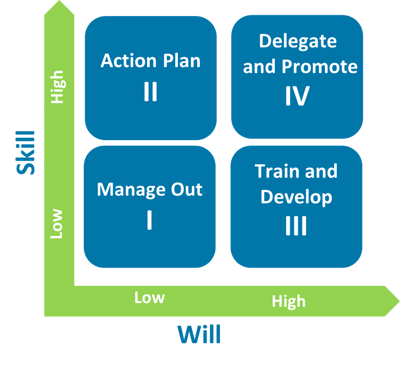
5 Tips to Help You Attract, Hire and Retain Top Sales Talent
Categories: Talent Management
Build a process you and your managers can leverage to make your B2B sales talent a competitive advantage. The remote and hybrid work environment provides companies the opportunity to hire talent with fewer geographical restraints creating the ability for leaders to expand their talent pool. Your competition may be leveraging that talent pool to build its sales team, and may be swiping your top performers. If you're considering a renewed focus on your sales talent approach, ensure you have the right foundations to make people successful in your organization and avoid your top talent jumping ship.
With more options and more competition, you have the opportunity to ensure you’re maximizing your talent approach. Take ownership of your talent and coaching process.
1. Establish what good looks like so your team can hire and coach against it
Revenue-driving sales teams often have a clear definition of the traits of top-performing sales talent within their specific organization. The leaders and managers in those organizations use those traits to create Success Profiles that they can use to hire, promote and coach against. A great Success Profile defines the fundamental attributes of someone successful in a specific position. This profile is not a job description. It’s a combination of:
- The success competencies for the position; the knowledge required to effectively perform the job.
- The success behaviors; what those competencies look like when the job is being performed effectively.
Get specific with your success profiles. Clearly define the knowledge, skills and behaviors people need to succeed in your sales organization. Build one for each critical sales role in your organization (rep, BDR/SDR, front-line manager, mid-level manager, even CRO). Having defined success profiles for each role can help you point reps and managers to what good looks like in their positions, giving you and your leaders something to coach against and drive accountability around.
2. Always be recruiting
Once you have a clear success profile, it becomes the gift that keeps on giving. Constantly leverage it to recruit and hire talent that will help you scale business growth. Recruiting top sales talent can be an ongoing, burdensome process for sales leaders. Focus on staying prepared for this rule of three:
- Someone will be promoted.
- Someone will resign or be fired.
- Someone will surprise you.
Sales talent management needs to be a consistent priority for you and your sales managers, if you want to attract, hire and retain top sales talent. Human resources can help, but they shouldn’t be the lead owner of your recruiting efforts. While staying consistent with your recruiting efforts can be overwhelming, there are simple tactics, tools and processes you can implement to support your managers and HR teams in improving your talent bench.
3. Meet your people where they are so you can build a team of top performers
Losing customers to the competition is bad enough, but if your sales reps are running to the competition too, you have a talent process that you need to improve. Successful leaders take into account their people’s skill level and motivation to coach them to success. A simple matrix called the Skill/Will model provides an easy way for you to achieve the same outcomes. Use this framework as a way to improve your sales talent processes.
The Y-axis represents “Skill,” or a person's ability to do a given job. The X-axis represents “Will”, or his/her motivation. These four buckets give you the information you need to assess your people and adapt you and your manager’s leadership approaches accordingly.

Understand what each box represents and how to coach your people accordingly. We just launched an entire podcast series on the Skill/Will coaching approach. Listen and share with other leaders in your organization, particularly front-line managers.
- Own Your Coaching Process
- Coaching Your 3s and 4s (high-will people)
- Coaching Your 1s and 2s (low-will people)
4. Coach your coaches to impact front-line results
Effective manager coaching can be the key component to getting a new hire up-to-speed quickly and driving repeatable performance from the best-of-the-best on the team. Can your managers provide effective feedback? Are they making an impact in opportunity coaching sessions, teaching repeatable sales skills and improving front-line execution? Do your managers stay in sync with new and seasoned reps on their team or is there evidence of a disconnect?
While there are endless difficult jobs in any business, the role of the front-line manager is one of the most difficult in the entire organization. Often sales managers aren’t trained for their critical roles. While they were promoted because they were excellent at sales, they are often underdeveloped at teaching the skills that came naturally to them as sellers. As a sales leader, you have the opportunity to build your managers into great sales coaches. Take a look at our comprehensive guide with the best resources for building strong sales coaches. In it, you'll find actionable tools and processes you can use to develop your sales managers into coaches that drive repeatable front-line impacts.
5. Implement a Management Operating Rhythm® to help your coaches make an impact
When it comes to building and retaining sales talent, participate in your own rescue by implementing a Management Operating Rhythm®, or MOR. When implemented effectively, a successful MOR provides you with an unrestricted line of sight into the performance of your sales teams. It equips you with the processes and tools leaders need to provide structured coaching to your entire team around current opportunities and other key sales activities.
Implement a MOR into your organization to ensure you and your managers execute the tactics necessary to retain talent and improve front-line execution. When building and implementing a MOR, here are some best practices to consider.
Cut New Hire Ramp-Up Time by 50%
Improving ramp-up time is a combination of coaching top performers and enabling that talent to be successful. Elite companies have found that implementing a buyer-focused messaging framework helps them ensure that right away, new hires have a simple framework for generating pipelines and winning those deals. Sysdig is an example of a company that enabled its growing sales organization to execute where it matters most, in front of high-level buyers. Implementing a buyer-focused sales message and qualification process enabled their sales organization to cut ramp-up time by 50% and double conversion rates.
Read their story to see how you may be able to make similar strides.


